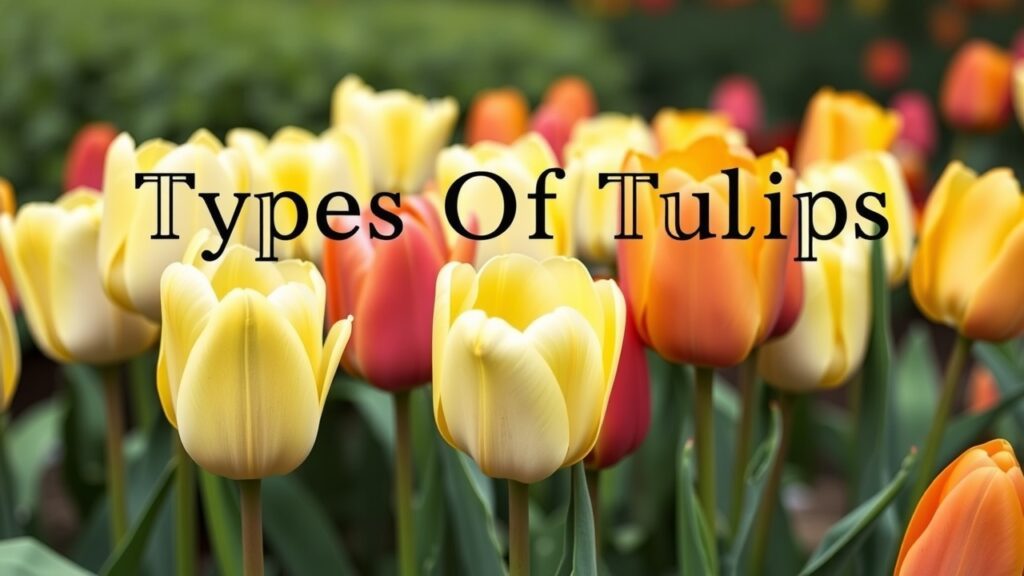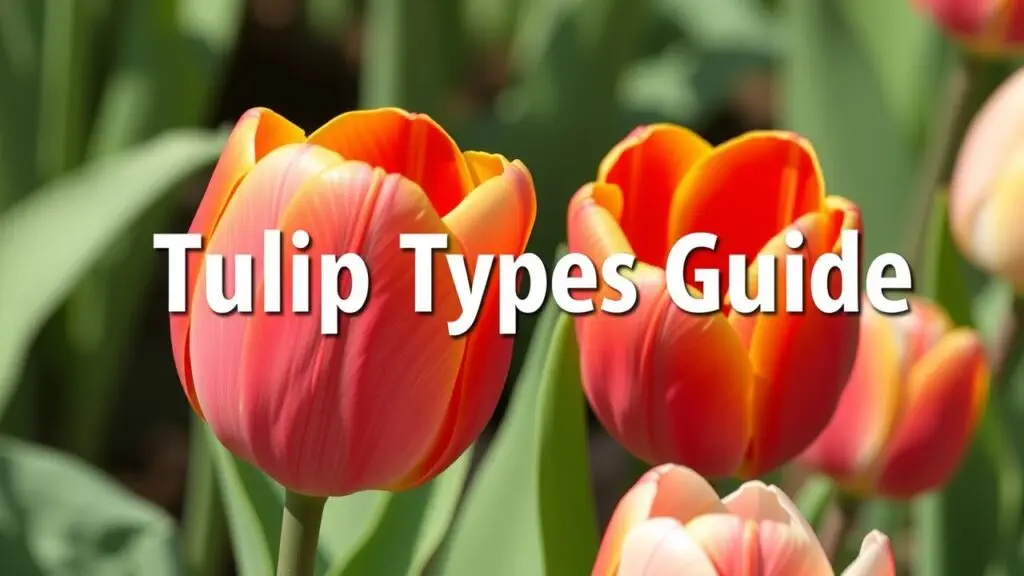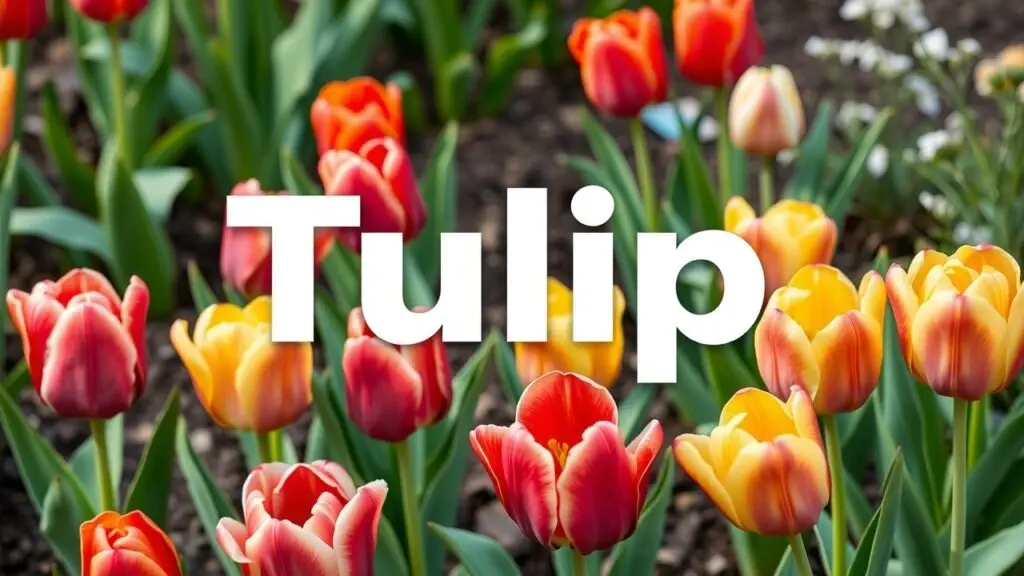Types of tulips are varied, offering a wide array of colors and shapes for your garden. This guide explores popular tulip types, from classic garden tulips to rare varieties, helping you choose the perfect blooms.
What Are Tulips?

Tulips are colorful flowers that belong to the genus Tulipa, which is part of the Liliaceae family. These botanical tulips come from Central Asia and have a long history, especially in Turkey, where they were grown a lot before reaching Europe. The Dutch became famous for their tulip cultivation, leading to many varieties and colors today. There are more than 150 species of tulips and thousands of hybrids, making them popular flowers that bloom in spring.
Why Understanding Types of Tulips Matters?
Knowing about the different types of tulips is important for garden design. Each type has unique traits like color, size, shape, and when they bloom. By learning these differences, gardeners can create beautiful displays with tulips blooming at different times throughout the season. Additionally, some types need specific care like more sunlight or certain soil types. This knowledge helps gardeners grow healthy and vibrant flowers.
How Are Tulips Classified?
Tulips are mainly classified by their flower shape and when they bloom. Here’s a quick look:
| Classification Type | Description | Bloom Time |
|---|---|---|
| Early-Blooming Tulips | These flowers bloom early in spring | March – April |
| Triumph Tulips | They have classic cup-shaped blooms | Mid-April |
| Darwin Hybrid Tulips | These have large flowers with strong stems | Late April – May |
| Double Tulips | They look like peonies with full petals | Late April – May |
| Fringed Tulips | Their edges are decorated with fringes | Mid-April – May |
Each type appeals to different tastes based on looks and growth habits. Knowing how these classifications work helps gardeners choose varieties that match their desired garden appearance while considering bloom times as well.
Comprehensive Guide to Types of Tulip Flowers
Early Blooming Varieties (Spring’s First Blooms)
Single Early Tulips: These tulips pop up first in spring. They show off bright colors and simple shapes. Two great examples are ‘Apricot Beauty’ and ‘Yokohama.’ ‘Apricot Beauty’ has soft peach petals, perfect for lighting up any garden. On the other hand, ‘Yokohama’ shines with its bold yellow color. Single early tulips work well in borders and containers, giving your garden a cheerful look as winter melts away.
Double Early Tulips: These tulips are known for their full blooms. They really grab attention. Varieties like ‘Ice Cream’ have creamy white petals with pink edges. Meanwhile, ‘Monte Carlo’ stands out with its bright yellow flowers. These tulips are great for cut flowers or potted displays because they have strong stems.
Mid-Spring Bloomers (Reliable Garden Staples)
Triumph Tulips: Triumph tulips bloom reliably in mid-spring. They have medium-sized flowers and combine the best traits of both single and double types. Notable picks like ‘Negrita’ feature deep purple petals, while ‘Strong Gold’ shows off sunny yellow blossoms. These tulips fit well into landscaping projects or mixed flower beds, making them versatile choices.
Late Spring Blooming Varieties (Showstoppers at Season’s End)
Darwin Hybrid Tulips: Known for their large blooms on sturdy stems, Darwin hybrid tulips steal the show late in spring. Popular cultivars like ‘Apeldoorn’ display classic red flowers with golden touches, while ‘Daydream’ offers a warm blend of orange shades. These varieties shine in cutting gardens, lasting beautifully when arranged indoors.
Single Late/Mayflowering Tulips: The last to bloom each spring, single late bulbs deliver bold displays. Varieties such as ‘Queen of Night’ boast dark maroon petals that add depth to any arrangement. Meanwhile, ‘Ballade’ features an eye-catching striped pattern that brightens up your garden.
Double Late Peony-Like Blooms: For a touch of luxury in floral arrangements, double late peony-like blooms are ideal. With layers of petals similar to peonies, varieties like ‘Angelique’ offer soft pink tones while ’La Belle Epoque’ blends warm apricot shades. These types enhance any bouquet with their added texture.
This guide gives you an overview of different types of tulip flowers suited for various gardening needs throughout the blooming season—from early bursts of color to grand finales later in spring. Whether you’re planting for beauty or cutting bouquets, there’s a tulip variety perfect for your needs!
Specialty & Unique Types of Garden-Friendly Bulbs
Exotic Shapes & Textures
Lily-flowered and fringed tulips are special types that bring unique beauty to gardens. Lily-flowered tulips have pointed petals shaped like stars, creating a graceful look. They move gently in the wind, making them eye-catching. Fringed tulips, on the other hand, have delicate edges that appear feathery, adding charm and whimsy. Both types enhance garden design and can be focal points in floral arrangements.
Lily-Flowered Tulips
Lily-flowered tulips, also known as Kaufmanniana tulips, are famous for their star-like pointed petals. Cultivars like ‘West Point’ shine with bright yellow blooms marked in red, while ‘Red Shine’ features deep red flowers. These varieties grow best in well-drained soil with plenty of sunlight. They fit nicely into borders or mixed flower beds, where they can complement other spring flowers beautifully.
Fringed Petal Varieties
Fringed petal varieties add a playful touch to any garden thanks to their whimsical frills along the edges. Flowers such as ‘Fancy Frills’ dazzle with intricate patterns and soft colors. Meanwhile, ‘Hamilton’ offers bold shades paired with its fanciful fringe design. These delightful blooms not only stand out in gardens but also make lovely additions to floral arrangements.
Rare Colors & Patterns
Viridiflora bulbs let gardeners explore rare colors within tulip species. A prime example is ’Spring Green,’ which displays striking green markings against classic colors like white or cream. Their uniqueness makes them popular among enthusiasts who want to create displays with uncommon hues.
Additional Unique Types
Parrot Tulips
Parrot tulip varieties are loved for their flamboyant feather-like edges that give them an exotic look. For instance, ‘Black Parrot’ shows off dark purple petals with ruffled edges. To care for these vibrant blooms, ensure they get plenty of sunlight and have well-draining soil.
Rembrandt Tulips
Rembrandt types are special because of their historical roots and distinct color patterns that resemble brush strokes from classic paintings. These dramatic effects can create striking visuals in any landscape setting.
Multi-Floral Tulip Varieties
Multi-flowering species are interesting because they produce clusters of flowers from a single bulb instead of just one bloom per plant. This characteristic adds beauty when planted along borders or in containers, where colorful impacts are desired but space is limited.
Species Tulip Varieties
Species bulbs like Greigii and Fosteriana are appreciated for their toughness and ability to naturalize over time. These traits make them great choices for rock gardens since they thrive in various conditions while still offering lovely seasonal displays.
Choosing the Right Tulips for Your Garden

When picking tulips for your garden, you want a mix of colors, heights, and bloom times. It helps to know about bloom times, how tall they grow, color options, and the right growing conditions. Also, if you want tulips indoors, you can force them to bloom early.
Bloom Time Considerations
Tulip bloom times matter if you want your garden to look colorful throughout spring. Here’s how the blooming periods break down:
- Early Spring Bloomers: These tulips flower from late March to early April. Examples are ‘Single Early’ tulips like ‘Darwin Hybrid’.
- Mid-Spring Bloomers: These bloom from mid-April to early May. Varieties such as ‘Triumph’ and ‘Parrot’ are popular choices.
- Late Spring Bloomers: You’ll see these tulips blooming from late April through May. Look for varieties like ‘Double Late’ or fringed types.
Mixing these different types will keep your garden colorful all spring long.
Height Considerations
The height of your tulips affects how they fit into your garden design. Here are some height categories:
- Tall Tulips: Varieties like ‘Queen of Night’ can reach over 18 inches high. They look great at the back of flower beds.
- Short Tulips: Dwarf types like ‘Little Princess’ grow only 6–10 inches tall. These work well in front borders or pots.
Layering taller and shorter tulips adds visual interest and keeps smaller ones visible.
Color Palette Considerations
Tulip colors can change the vibe of your garden. Here are some popular color choices:
- Red Tulips: These stand out and make a bold statement.
- Yellow Tulips: Brighten up spaces with their sunny hues.
- Pink Tulips: Soft shades that bring a romantic feel.
- Purple & Orange Tulips: Use these for depth and contrast in your arrangements.
Choosing colors that go well together enhances your existing plants and creates a unique look.
Growing Conditions
Knowing the right growing conditions is key to successfully planting different types of tulip bulbs:
- Sunlight Needs: Most tulip varieties love full sun, which means at least six hours of light each day.
- Soil Drainage: Good drainage is super important! Waterlogged roots can rot easily. If your soil is heavy, add organic material to help it drain better.
- Planting Depth & Spacing: Generally, plant bulbs about 6–8 inches deep and space them around 4–6 inches apart based on size.
Taking these steps helps ensure strong growth and beautiful blooms every spring.
Indoor Forcing
Want to enjoy tulip blooms inside before spring hits? Choose early-blooming varieties when forcing bulbs:
- Look for single early types like ‘Apricot Beauty’ or double early ones such as ‘Peach Blossom’.
- Plant them in pots with potting mix about ten weeks before you want them to bloom—usually around December or January—so they can be ready by March!
This way, you bring some spring cheer indoors while waiting for warmer weather outside!
By keeping in mind bloom times, heights, colors, growing conditions, and indoor forcing methods, you’ll be ready to choose the best tulip bulbs for your style and garden space!
Tulip Care and Maintenance
Caring for tulips is all about knowing what they need to grow well. If you give them the right attention, these colorful flowers can light up your garden in spring. Here are some handy tips on tulip care that will help you cultivate and maintain them.
Planting Depth and Spacing
When you plant tulip bulbs, depth and spacing matter a lot. Generally, you should plant bulbs about 6 to 8 inches deep. This depth keeps them safe from temperature changes and helps their roots grow strong. For spacing, keep bulbs about 4 to 6 inches apart. This gives them space to breathe and stops overcrowding as they grow.
Best Practices for Planting Tulips:
- Pick a sunny spot with good drainage.
- Dig holes that fit the bulb size plus a little extra.
- Make sure the pointed end of the bulb faces up when planting.
Soil Preparation and Amendments
Tulips love well-drained soil that’s rich in organic matter. Before planting, loosen the soil with a spade or tiller to help it drain better. If your soil is heavy clay or sandy, add some compost or peat moss. These amendments will improve the soil’s structure.
Ideal Soil Conditions:
- Keep pH between 6.0 and 7.0.
- Good drainage is key; avoid standing water that can cause rot.
By prepping your soil properly, you create a great home for your tulips.
Watering and Fertilization
Watering needs depend on weather but aim for consistent moisture without soaking the soil too much. After you plant, water thoroughly but let the top inch of soil dry out before watering again during active growth.
For fertilization:
- Use a balanced fertilizer (like 10-10-10) when planting.
- Apply more after blooming if you want strong blooms next year.
Keeping track of watering and fertilizing will help your tulips bloom beautifully.
Protecting from Pests and Diseases
Common pests that bother tulips include aphids, slugs, and rabbits. To control these pests:
- Check plants often for signs of trouble.
- Use insecticidal soap or neem oil if needed.
- Think about using row covers as a physical barrier during sensitive times.
Diseases like botrytis blight can also harm tulips if it gets too humid; ensure there’s good air circulation around plants to prevent this issue.
Storing Bulbs for Next Year’s Planting
After blooming ends in late spring or early summer:
- Let the leaves die back on their own; this feeds the bulb underground.
- When leaves turn yellow-brown (about six weeks later), carefully dig up bulbs with a fork instead of pulling them out directly.
- Gently clean off extra dirt without harming any scales on the bulbs before storing them in a cool, dark place until it’s time to replant in fall.
By following these steps, you’ll enjoy beautiful blooms each year while setting yourself up for success with different types of tulips that enhance your garden!
Tulip-Inspired Projects and Ideas

Ideas for Using Tulips in Various Garden Designs
Tulips can really brighten up your garden, whether it’s a cozy cottage style or a sleek formal look. In a cottage garden, you can mix tulips with daffodils and hyacinths to create a soft, natural vibe. For a formal garden, plant rows of tulips in the same color or shape to keep it neat.
To make your garden more interesting, play with the height of your tulips. Place taller varieties, like Darwin Hybrid tulips, at the back. In front, use shorter types such as Triumph or Greigii tulips. This way, you can create layers that are visually appealing.
Color is key! Pair bright red tulips with soft yellows or whites for a striking look. If you want something more subtle, stick to shades of purple for an elegant feel across your landscape.
Inspiration for Creating Unique Floral Arrangements with Tulips
When you’re arranging flowers, mixing tulips with other seasonal blooms can make stunning displays. Think about using classic red or yellow tulips along with pastel ranunculus for beautiful centerpieces during spring events or weddings.
Look for unique tulip varieties too! Fringed or lily-flowered tulips add texture and charm to your bouquets. Choose colors that go well together—mix warm oranges with cool blues for eye-catching arrangements.
Also, consider the shapes in your bouquet. Combining round peonies with tall tulip forms adds interest and keeps things balanced.
Seasonal Decorating with Tulips
Potted tulips are perfect decorations during spring holidays like Easter or Mother’s Day! Their bright blooms bring cheer to your home as winter fades away.
To make your display even nicer, pair blooming pots with candles or vases filled with greenery. This setup enhances their colors without being too busy.
Creative Uses Beyond the Garden
Tulip petals aren’t just pretty; they can be used creatively! Try drying them to make potpourri that fills rooms with natural fragrance. Pressed petal art also offers unique decor options that show off personal styles.
You can also add photographs inspired by colorful tulips into your home decor themes. This brings in artistic expression beyond just gardening!
Don’t be afraid to play around with different types of tulips in your projects! Everyone has their own style and space preferences, so have fun experimenting year-round!
FAQs about Types of Tulips
What are the main types of tulips?
The main types of tulips include early-blooming, triumph, Darwin hybrid, double, and fringed tulips. Each type has distinct characteristics and bloom times.
What colors do tulips come in?
Tulips feature a variety of colors, including red, yellow, pink, purple, and even rare green varieties. The colors can convey different meanings and emotions.
Which tulip varieties are best for cutting?
Darwin hybrids and parrot tulips are popular for cut flowers due to their strong stems and lasting blooms.
What is the best time to plant tulip bulbs?
Plant tulip bulbs in the fall between September and November for optimal growth.
How do I care for my tulips after blooming?
Allow the leaves to die back naturally. This process helps the bulbs store energy for next year’s growth.
What conditions do tulips need to thrive?
Tulips prefer full sun and well-drained soil. Ensure they get enough sunlight for healthy growth.
How can I store tulip bulbs?
Store bulbs in a cool, dark place. Use paper bags or mesh sacks for proper air circulation.
Unique Aspects of Tulip Cultivation
- Tulip Symbolism: Different colors represent various meanings. Red symbolizes love. Yellow stands for cheerfulness. White represents purity.
- Tulip History: Tulips originated from Central Asia. They became popular in Europe during the Dutch Golden Age.
- Tulip Festivals: Many places celebrate tulip festivals each spring. Events showcase vibrant blooms in gardens like Keukenhof in the Netherlands.
- Tulip Pests and Diseases: Common pests include aphids and slugs. Good air circulation helps prevent diseases like botrytis blight.
- Tulip Propagation: Plant bulbs in groups for visual impact. Allow them to naturalize by leaving some in the ground year-round.
- Unusual Tulip Varieties: Explore unique types such as fringed or parrot tulips. These add character to any garden display.
- Growing Conditions: Tulips grow best with six hours of sunlight daily. Avoid waterlogged soil to prevent bulb rot.
These elements enhance your understanding of types of tulips and their cultivation needs while providing a rich resource for your gardening journey.
Related Topics
- Types of Tulip Blooms
- Types of Early Blooming Tulips
- Types of Mid-Spring Blooming Tulips
- Types of Late Spring Blooming Tulips
- Types of Tulip Colors
- Types of Tulip Pests
- Types of Tulip Diseases
- Types of Tulip Soil
- Types of Tulip Fertilizers
- Types of Tulip Arrangements
- Types of Tulip Garden Designs
- Types of Tulip Festivals
- Types of Tulip Art
- Types of Tulip Symbolism



Types of Tulips: A Guide to Tulip Varieties, Colors, and Meanings